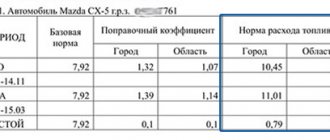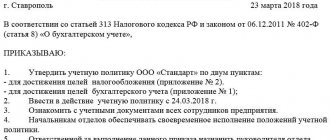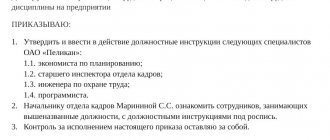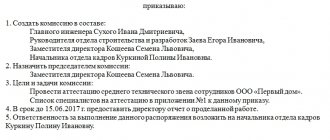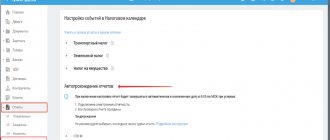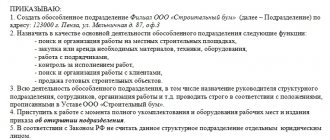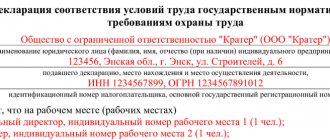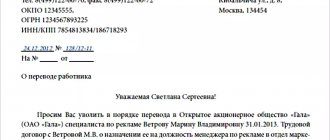When is such an order issued?
Many companies use road transport in their activities.
When operating vehicles, costs inevitably arise for the purchase of fuels and lubricants. There is currently no strictly standardized write-off procedure for commercial organizations established by the state, and the organization has the right to establish its own by issuing an order on fuel consumption standards. The need for rationing is dictated by the requirements of regulatory authorities: any costs must be justified and documented. On the other hand, setting fuel consumption according to clear standards allows responsible persons to control its purchase. Use free instructions from ConsultantPlus experts to correctly calculate fuel consumption.
Normative base
When issuing an order to approve the fuel and lubricants standard, the organization is guided by the volume of fuel consumption recommended by Order of the Ministry of Transport of the Russian Federation No. AM-23-R dated March 14, 2008. It reflects the rationing of fuels and lubricants by type of vehicle and the procedure for recalculation under special operating conditions of the vehicle.
If the vehicle is not listed in Order AM-23-R, you should refer to the manufacturer’s technical documentation.
In letter No. 03-03-07/74189 dated September 26, 2019, the Ministry of Finance confirmed that the organization has the right to issue an order to write off fuel and lubricants based on actual consumption. But documentary evidence and economic justification of the amount of costs and confirmation that they were incurred in carrying out activities aimed at generating income are required.
Calculation rules
The amount of fuel consumed by any vehicle depends both on the basic normalized write-off volume and on the conditions of its operation, and the order on fuel and lubricants consumption standards establishes the write-off volume, calculated taking into account all parties.
To make the calculation correctly, you need to decide on the basic normalized write-off volume:
- refer to Order AM-23-R;
- if the car is not mentioned by the Ministry of Transport in the order, refer to the technical documentation of the manufacturer;
- if the transport is heavily worn out or the operating conditions are specific, the organization has the right to carry out control measurements itself and determine the amount of write-off, taking into account the opinion of the internal commission.
This is a sample order on fuel consumption rates in summer and winter, drawn up according to all the rules:
Fuel consumption standards are adjusted by established coefficients that take into account operating conditions:
| terms of Use | Applicable coefficients |
| Mountain landscape | 5-20%, depending on altitude |
| Settlements | 2-35%, depending on the number. The maximum coefficient applies only to cities with a population of more than 5 million people. |
| New cars | Up to 10% for the break-in period |
| Operation more than 5 years or mileage more than 100,000 km | Up to 5% |
| Operation more than 8 years or mileage more than 150,000 km | To 10% |
| Using the climate control system | Up to 7% |
A current sample of an order establishing fuel consumption standards in 2022, taking into account control races.
Establishment (development) of fuel consumption standards
1.1. Units of measurement of fuel consumption standards
The following units of measurement of fuel consumption standards are used (clause 4 of Instruction No. 141):
| Liter per 100 km (l/100 km) of a car running on gasoline , diesel fuel or liquefied petroleum gas ( LPG ) | Cubic meter per 100 km (m3/100 km) of a vehicle running on compressed natural |
tractor, machine, mechanism and equipment (l/machine-hour)
Liter per performing one operationtractor, machine, mechanism and equipment
| For information Machine hour is the actual operating time of the tractor, machine, mechanism and equipment, measured in astronomical hours (paragraph 10, part 1, clause 3 of Instruction No. 141). |
The fuel consumption rate for a motor vehicle or machine running on LPG or CNG, in the absence of an established LPG or CNG consumption rate, is accepted as higher than the corresponding gasoline consumption rate for the corresponding model (modification):
• for LPG - no more than 25%;
• for LNG - no more than 5% (clause 9 of Instruction No. 141).
| Additional on topic • The enterprise has refueling equipment for diesel fuel. Fuel is purchased according to the technical specification, which reflects its quantity in tons and liters, indicating the density at the time of purchase. How to correctly reflect fuel consumption and its balance in the warehouse - in kilograms or liters, taking into account density or not? |
1.2. The procedure for establishing and using fuel consumption standards
Fuel consumption standards for models (modifications) of motor vehicles, machines, mechanisms and equipment are established by the Ministry of Transport as recommended
and within a year undergo operational testing in organizations operating these models (modifications) of equipment. After a year, fuel consumption standards are adjusted, if necessary, taking into account the results of the operational check (Part 1, Clause 6 of Instruction No. 141).
Fuel costs
for motor vehicles, ships, machines, mechanisms and equipment, spent
within the limits established by the head of the organization independently
or on the basis of test results conducted by an accredited testing laboratory (center),
when calculating income tax, they are considered standard costs
(subclause 1.2 p. .1 Article 171 of the Tax Code; subparagraph 1.1 clause 1 of Resolution No. 470; letter of the Ministry of Taxes dated September 15, 2020 No. 2-2-10/01946-1).
Fuel consumption standards calculated on the basis of Instruction No. 141 are intended for use by organizations and individual entrepreneurs registered on the territory of the Republic of Belarus when operating motor vehicles, machines, mechanisms and equipment.
When using cars for international transport, the fuel consumption rate is set by the heads of organizations or individual entrepreneurs (clause 2 of Instruction No. 141).
| For information International road transport - road transport carried out outside (outside) the territory of the Republic of Belarus, from beyond its borders, as well as transit road transport carried out through the territory of the Republic of Belarus between two crossing points of the State border of the Republic of Belarus in places established by law (paragraph .14 part 1 clause 3 of Instruction No. 141). |
If the organization (factory) - manufacturer or its official representative confirms in writing that a specific modification of a power-driven vehicle, machine, mechanism and equipment does not have design differences from the corresponding model of a power-driven vehicle, machine, mechanism and equipment that affects fuel consumption, then the fuel consumption rate for the corresponding model of motor vehicle, machine, mechanism and equipment (clause 26 of Instruction No. 141).
| Additional on topic • Application in 2022 of fuel consumption standards independently established by the head of the organization. • We refuel self-propelled vehicles and write off fuel according to standards. • Costs of maintenance and operation of motor transport: legislation regulating the procedure for including costs in the cost price when setting prices. • The organization has established fuel consumption standards, the equipment is in good condition. Does the employer have the right to deduct from the employee’s wages the cost of burning fuel consumed in excess of the norm? • Until 2022, the organization had cars for which fuel consumption standards were established by the manager and were not approved by law. The organization did not take into account fuel consumption for them when taxing profits. Is it necessary to apply the norms of Resolution of the Council of Ministers of the Republic of Belarus dated August 10, 2020 No. 470 “On the procedure for establishing fuel consumption standards” if the organization does not want to recalculate fuel consumption for previous years? • An employee of the organization purchased fuel to refuel a company car using personal funds (payment was made using a bank payment card). The next day, an advance report was submitted to the accounting department with an attached copy of the payment document (check) issued on the cash register used at the gas station. In this situation, can an organization take fuel into account and include the cost of purchased fuel in the costs taken into account when taxing profits (the trip was of a production nature)? • The manager has established a fuel consumption standard for a new official passenger car (due to the fact that there is no standard for this car approved by the Ministry of Transport and Communications of the Republic of Belarus). The organization did not apply to the accredited Transtechnika laboratory to develop the standard. During what period of time does an organization have the right to take into account fuel costs for taxation within the limits approved by the head? • In the Decree of the Ministry of Transport and Communications of the Republic of Belarus dated 01.08.2019 No. 44 “On establishing fuel consumption standards in the field of transport activities,” fuel consumption standards apply to some brands of cars depending on the engine, indicating specific models. In the Decree of the Ministry of Transport and Communications of the Republic of Belarus dated November 14, 2019 No. 50 “On establishing fuel consumption standards in the field of transport activities,” this clarification is missing. How are the provisions of these two regulations applied? • The organization provides services to the sugar plant for loading beets into wagons using beet-loading equipment and unloading cars on the site with special beet-laying machines. BelNIIT "Transtechnika" refused to develop fuel consumption standards for these types of equipment. The fuel consumption standards for these types of equipment were developed by the Republican Regulatory Research Center. Should these standards be approved by the Ministry of Agriculture and Food of the Republic of Belarus? • A commercial organization entered into a purchase and sale agreement with an individual for the purchase of a used car. Car model: Toyota Highlander 3.5VVT-i (8 automatic transmission) 4WD. In Appendix 1 to the resolution of the Ministry of Transport and Communications of the Republic of Belarus dated 01.08.2019 No. 44 “On establishing fuel consumption standards in the field of transport activities,” this car is named in paragraph 1157 with a standard of 12.0 B. The car being purchased is a hybrid. Is it possible to use the rate specified in the application to write off fuel? • The organization has vehicles - tractors and semi-trailers and a license to carry out activities in the field of road transport. BelNIIT "Transtechnika" standards have been developed for one car. Is writing off fuel for this car a standard cost? • Standard fuel consumption calculator. Reference Information: • Fuel consumption standards. |
1.3. Temporary standards
| For information Temporary fuel consumption rate - the amount of fuel consumed by the engine of a motor vehicle, machine, mechanism and equipment, corresponding to the control fuel consumption established by the organization (factory) - manufacturer in the operating instructions for this motor vehicle, machine, mechanism, equipment (paragraph 9 Part 1, Clause 3 of Instruction No. 141). |
In the absence of a fuel consumption standard established by the Ministry of Transport before its establishment, fuel consumption during the operation of a mechanical vehicle, machine, mechanism and equipment in the Republic of Belarus is taken into account according to a temporary standard for a period of no more than 6 months
(Part 1, Clause 7 of Instruction No. 141).
In the absence of a control fuel consumption established by the manufacturer, a temporary fuel consumption rate is established by the head of the organization or individual entrepreneur (Part 2, Clause 7 of Instruction No. 141).
| Note! After the release of Resolution No. 470, fuel consumption standards can be set by the heads of organizations and individual entrepreneurs independently or based on test results conducted by an accredited testing laboratory (center) (subclause 1.2 clause 1 of Article 171 of the Tax Code; subclause 1.1 clause 1 of Resolution No. 470). In such conditions, the limitation of the period of application of the temporary norm to 6 months provided for by Instruction No. 141 actually became invalid . |
Fuel consumption according to a temporary standard (until the Ministry of Transport establishes a fuel consumption standard) is also taken into account by organizations operating outside the Republic of Belarus, diplomatic missions and consular offices of the Republic of Belarus (Part 3, Clause 7 of Instruction No. 141).
| For information Services for the development of fuel consumption standards for motor vehicles, machines, mechanisms and equipment are provided by BelNIIT "Transtechnika". |
| Additional on topic • In December 2022, the organization purchased a vehicle. There is no fuel consumption standard established by law. Now the standard established by the manufacturer applies. How and according to what organizational standards should fuel be rationed and kept records so that this would be acceptable when calculating income tax, and would be the basis for writing off fuel and lubricants as production costs in accounting? |
Features of summer and winter operation
When rationing gasoline write-offs, summer consumption is calculated and recorded in a separate order. Order AM-23-R allows gasoline to be written off in a larger amount in the winter. For each region of the Russian Federation, a special increasing coefficient has been established from 5 to 20% and the timing of the winter period. For central Russia it is 10%. It can be used from November to March by issuing an order to increase consumption.
This is what a sample order to increase the fuel consumption of transport for the winter period of 2022-2023 looks like.
| ORDER Saint Petersburg "30" October 2022 No. 215 “On the transition to winter fuel consumption standards” Due to the onset of the winter period, in accordance with the provisions of the Order of the Ministry of Transport of Russia No. AM-23-r dated March 14, 2008, I ORDER:
General Director ____________________________ P.P. Petrov |
It is possible to prescribe the rationing of summer and winter consumption of fuel and lubricants in one local regulatory act. Then you won’t have to issue separate orders for summer and winter.
Fuel consumption in special cases and operating conditions
5.1. Gasoline consumption to start the engine
When operating a vehicle running on CNG and LPG, gasoline consumption per engine start is set from the linear gasoline consumption rate (for the corresponding vehicle model) depending on the ambient temperature (clause 18 of Instruction No. 141):
| Ambient temperature | Gasoline consumption per engine start (from the linear norm) |
| Over +5°С | No more than 1% (for injection engines) |
| From +5 to -10°С | No more than 3% |
| Below -10°C | No more than 5% |
5.2. Movement in maintenance and repair areas for vehicles running on CNG and LPG
When moving in maintenance and routine repair areas for vehicles running on CNG and LPG, gasoline consumption is set at no more than 10% of the linear gasoline consumption rate established for the corresponding vehicle model (clause 23 of Instruction No. 141).
5.3. In-garage travel and technical needs
For intra-garage trips and technical needs (technical inspections, adjustment work, running-in of car engine parts after repairs), monthly fuel consumption should not exceed 0.5% of the total amount consumed by the vehicles in use, in the absence of savings (clause 24 of Instruction No. 141) .
5.4. Operating a training vehicle on a racing track
When operating a car involved in learning how to drive a power-driven vehicle on a motor racing track, 1 vehicle-hour of exercises is equivalent to fuel consumption per 20 km (clause 17 of Instruction No. 141).
| Additional on topic • Reimbursement of fuel costs for driving school students. • Summary sheet of actual fuel consumption (example). |
5.5. Dump Truck Operation
The increase (decrease) in fuel consumption depends on the type of dump truck and its operating conditions (clause 20 of Instruction No. 141):
| Operating a dump truck with a dump trailer or a tractor unit with a dump semi-trailer | Operation of a dump truck (tipping road train) with a load capacity utilization factor different from 0.5 |
| Fuel consumption increases for each ton of curb weight of the trailer (semi-trailer) and 50% of the weight of the cargo transported on the trailer (with a load capacity utilization factor of 0.5): | Fuel consumption increases or decreases for every 100 t km of overfulfilled or underfulfilled transport work in relation to transport work performed at a load capacity utilization factor of 0.5: |
| gasoline - no more than 2 liters; diesel fuel - no more than 1.3 l; LNG - no more than 2 m3; LPG - no more than 2.5 l; for the gas-diesel cycle - no more than 1.2 m3 of LNG and no more than 0.25 liters of diesel fuel | |
When operating a dump truck or tipper road train (as well as a truck tractor with a tipper semi-trailer), the increase in fuel consumption for each trip with a load depends on the load capacity
(paragraph 22 of Instruction No. 141):
| Load capacity | Increased fuel consumption | |
| during normal work | when working in a quarry with maneuvering in loading and unloading areas | |
| Up to 10 t | No more than 0.25 liters of gasoline, diesel fuel or LPG; 0.3 m3 - LNG | No more than 0.2 liters of gasoline, diesel fuel or LPG; 0.3 m3 - LNG |
| From 10 to 20 t | No more than 0.5 liters of diesel fuel | No more than 0.3 liters of diesel fuel |
| Over 20 t | No more than 1.0 liters of diesel fuel | No more than 0.4 liters of diesel fuel |
5.6. Operating a special vehicle
When operating a special vehicle that has no design differences
from a similar model for the engine, gearbox, final drive, tires, wheel arrangement, body, curb weight, which affect fuel consumption, the established linear fuel consumption rate for the corresponding model (modification) of the car is applied (clause 25.1, clause 25 of Instruction No. 141 ).
When operating a special vehicle that differs
from a similar model
only with a curb weight and having no other design differences
that affect fuel consumption, the linear fuel consumption rate increases (decreases) for each ton of excess (decrease) in the weight of such a car: running on gasoline - no more than 2 liters; diesel fuel - no more than 1.3 l; LNG - no more than 2 m3; LPG - no more than 2.5 liters (clause 25.2, clause 25 of Instruction No. 141).
